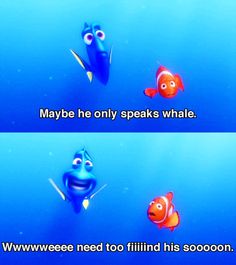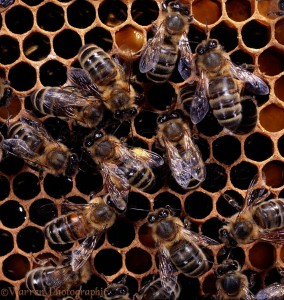
Dory demonstrates her ability to speak whale in Finding Nemo. Dory is trying to break down the language barrier between “human” language and whale speak. Does that mean language is universal across all species or is language only unique to humans?
Many animals have ways of communicating information throughout their colony, tribe, school, etc. For example, if a honeybee wants to tell his friends about all the flowers waiting to be pollinated, he performs a special dance, often called the waggle dance. The waggle dance signifies to the other bees the precise direction and distance that a flower is located. The honeybee enters the colony and shakes his tail back and forth, the speed signaling the distance, and moves around in a figure eight pattern, signaling the direction of the food source.
Dolphins communicate in intricate ways as well. Not only do they use bodily movements and gestures to communicate, they also have their own special kind of language made up of whistles, squeaks, and clicks.  Researchers have spent decades attempting to crack the code of dolphin speak, but with no luck. Dolphins, like whales and being elusive when underwater, display many of the same gestures when interacting with each other when playing and fighting, making it difficult for researchers to derive meaning from their sounds and movements.
Researchers have spent decades attempting to crack the code of dolphin speak, but with no luck. Dolphins, like whales and being elusive when underwater, display many of the same gestures when interacting with each other when playing and fighting, making it difficult for researchers to derive meaning from their sounds and movements.
The parrot also shows ways of communicating that are much different from dolphins and honeybees. Parrots can learn to speak all sorts of different human languages. One special parrot, Alex, learned over 150 words of the English language, the difference between small and large, the abstract concept of numbers and counting, and other lingual skills that humans possess. His trainer, Irene Pepperberg, believed Alex could truly understand her and had a language acquisition comparable to humans. Professor Pepperberg chronicles many accounts of Alex’s intelligence in picking up words and linking them to the appropriate situations, such as apologizing when he did something wrong or saying “I love you” when the professor left the lab at the end of the day. Pepperberg continued to train other parrots as well, but never any quite as smart as Alex.
But can it really be said that animals possess the same kind of language that humans do? Certainly it cannot be said that honeybees and dolphins interact the same using grammar and syntax rules found in the English language as humans do. Alex the parrot possessed an immense amount of human-like lingual characteristics, but he also lacked a good portion as well. So what makes human language unique from honeybee, dolphin, or parrot language? Let us explore.
It is easy to contrast between human language and the honeybee or dolphin’s means of communication. Honeybees do not use words or construct sentences as humans do. They do not understand the concepts of past and future. With their main goal in life being to collect pollen and food, it would be trivial for them to sit around their hive discussing Noam Chomsky’s take on language acquisition. However, that is not to say that their communication forms are in any way unintelligent, but rather are of a different intelligence than humans are able to comprehend. When it comes to dolphins, humans cannot properly imitate their speech patterns or even begin to make sense of their subtle clicks and whistles.
“The capacity of humans to systematically turn conceptual ideas into limitlessly creative word sequences is truly unparalleled in nature.”
A parrot, it would seem, comes the closest to using human speech. But is it perhaps just mimicry? It is not hard to find a parrot that will imitate the words you speak, but one that can learn to match meaning to the words they repeat is more intriguing. Professor Pepperberg would certainly argue that her parrot learned the English language as it can decipher between objects big and small, same or different, as well as learn words and fit them to context. Mimicry is a far cry from the clear intellect that Alex the parrot possessed, but it cannot be concluded that the parrot has the same language skills as humans.
Grammar and syntax is a large part of the human language. We can take meaningless letters and arrange them to form a meaningful word. We can “create nonsensical yet understandable sentences like ‘Colorless green ideas sleep furiously.’” We have the privilege of communicating more than what is necessary, such as saying, “This blog post is top-notch” or “Burgers are better with cheese.” Honeybees do not say to each other “Hmm, I wish I had some toast to spread all this honey on.” Dolphins, for all we know, do not swim around quoting Shakespeare. And parrots certainly do not have the capacity to relay to their hairdresser how they want their feathers ruffled for prom.
Human language is different. Animal languages allow animals to communicate about food, predators, or what have you. But human language is the capacity to communicate in infinite ways. We can string together infinite pairings of words to not only communicate, but to convey meaning. Communication is universal across all species on earth, but language, and all the complex ways it works within the brain, is unique to the human experience alone.
Sources:
http://www.bbc.com/future/story/20121016-is-language-unique-to-humans
https://www.quora.com/Noam-Chomsky-has-said-that-human-language-is-unique-in-the-biological-world-Is-he-correct
http://www.dailymail.co.uk/news/article-2458346/Parrot-learned-say-I-love-mean-word.html
http://www.columbia.edu/~rmk7/HC/HC_Readings/AnimalComm.pdf
http://kids.nationalgeographic.com/explore/nature/secret-language-of-dolphins/#dolphin-communication.jpg

